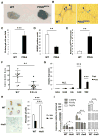Mitochondrial Dysfunction Induces Senescence with a Distinct Secretory Phenotype
- PMID: 26686024
- PMCID: PMC4749409
- DOI: 10.1016/j.cmet.2015.11.011
Mitochondrial Dysfunction Induces Senescence with a Distinct Secretory Phenotype
Abstract
Cellular senescence permanently arrests cell proliferation, often accompanied by a multi-faceted senescence-associated secretory phenotype (SASP). Loss of mitochondrial function can drive age-related declines in the function of many post-mitotic tissues, but little is known about how mitochondrial dysfunction affects mitotic tissues. We show here that several manipulations that compromise mitochondrial function in proliferating human cells induce a senescence growth arrest with a modified SASP that lacks the IL-1-dependent inflammatory arm. Cells that underwent mitochondrial dysfunction-associated senescence (MiDAS) had lower NAD+/NADH ratios, which caused both the growth arrest and prevented the IL-1-associated SASP through AMPK-mediated p53 activation. Progeroid mice that rapidly accrue mtDNA mutations accumulated senescent cells with a MiDAS SASP in vivo, which suppressed adipogenesis and stimulated keratinocyte differentiation in cell culture. Our data identify a distinct senescence response and provide a mechanism by which mitochondrial dysfunction can drive aging phenotypes.
Copyright © 2016 Elsevier Inc. All rights reserved.
Conflict of interest statement
The other authors declare no conflicts of interest.
Figures






Comment in
-
Mitochondrial Damage Induces Senescence with a Twisted Arm.Cell Metab. 2016 Feb 9;23(2):229-30. doi: 10.1016/j.cmet.2016.01.012. Cell Metab. 2016. PMID: 26863485
-
Mitochondrial Dysfunction Meets Senescence.Trends Biochem Sci. 2016 Mar;41(3):207-209. doi: 10.1016/j.tibs.2016.01.005. Epub 2016 Feb 11. Trends Biochem Sci. 2016. PMID: 26874922
References
Publication types
MeSH terms
Substances
Grants and funding
LinkOut - more resources
Full Text Sources
Other Literature Sources
Molecular Biology Databases
Research Materials
Miscellaneous

